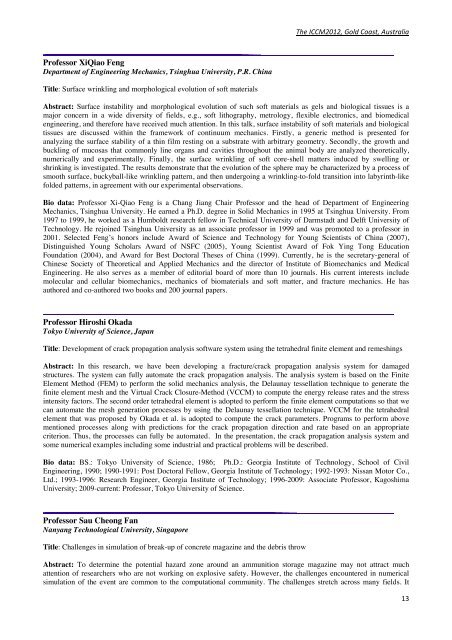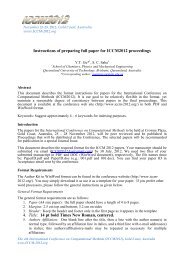detailed program for parallel sessions - The 4th International ...
detailed program for parallel sessions - The 4th International ...
detailed program for parallel sessions - The 4th International ...
You also want an ePaper? Increase the reach of your titles
YUMPU automatically turns print PDFs into web optimized ePapers that Google loves.
Professor XiQiao Feng<br />
Department of Engineering Mechanics, Tsinghua University, P.R. China<br />
Title: Surface wrinkling and morphological evolution of soft materials<br />
<strong>The</strong> ICCM2012, Gold Coast, Australia<br />
Abstract: Surface instability and morphological evolution of such soft materials as gels and biological tissues is a<br />
major concern in a wide diversity of fields, e.g., soft lithography, metrology, flexible electronics, and biomedical<br />
engineering, and there<strong>for</strong>e have received much attention. In this talk, surface instability of soft materials and biological<br />
tissues are discussed within the framework of continuum mechanics. Firstly, a generic method is presented <strong>for</strong><br />
analyzing the surface stability of a thin film resting on a substrate with arbitrary geometry. Secondly, the growth and<br />
buckling of mucosas that commonly line organs and cavities throughout the animal body are analyzed theoretically,<br />
numerically and experimentally. Finally, the surface wrinkling of soft core-shell matters induced by swelling or<br />
shrinking is investigated. <strong>The</strong> results demonstrate that the evolution of the sphere may be characterized by a process of<br />
smooth surface, buckyball-like wrinkling pattern, and then undergoing a wrinkling-to-fold transition into labyrinth-like<br />
folded patterns, in agreement with our experimental observations.<br />
Bio data: Professor Xi-Qiao Feng is a Chang Jiang Chair Professor and the head of Department of Engineering<br />
Mechanics, Tsinghua University. He earned a Ph.D. degree in Solid Mechanics in 1995 at Tsinghua University. From<br />
1997 to 1999, he worked as a Humboldt research fellow in Technical University of Darmstadt and Delft University of<br />
Technology. He rejoined Tsinghua University as an associate professor in 1999 and was promoted to a professor in<br />
2001. Selected Feng’s honors include Award of Science and Technology <strong>for</strong> Young Scientists of China (2007),<br />
Distinguished Young Scholars Award of NSFC (2005), Young Scientist Award of Fok Ying Tong Education<br />
Foundation (2004), and Award <strong>for</strong> Best Doctoral <strong>The</strong>ses of China (1999). Currently, he is the secretary-general of<br />
Chinese Society of <strong>The</strong>oretical and Applied Mechanics and the director of Institute of Biomechanics and Medical<br />
Engineering. He also serves as a member of editorial board of more than 10 journals. His current interests include<br />
molecular and cellular biomechanics, mechanics of biomaterials and soft matter, and fracture mechanics. He has<br />
authored and co-authored two books and 200 journal papers.<br />
Professor Hiroshi Okada<br />
Tokyo University of Science, Japan<br />
Title: Development of crack propagation analysis software system using the tetrahedral finite element and remeshings<br />
Abstract: In this research, we have been developing a fracture/crack propagation analysis system <strong>for</strong> damaged<br />
structures. <strong>The</strong> system can fully automate the crack propagation analysis. <strong>The</strong> analysis system is based on the Finite<br />
Element Method (FEM) to per<strong>for</strong>m the solid mechanics analysis, the Delaunay tessellation technique to generate the<br />
finite element mesh and the Virtual Crack Closure-Method (VCCM) to compute the energy release rates and the stress<br />
intensity factors. <strong>The</strong> second order tetrahedral element is adopted to per<strong>for</strong>m the finite element computations so that we<br />
can automate the mesh generation processes by using the Delaunay tessellation technique. VCCM <strong>for</strong> the tetrahedral<br />
element that was proposed by Okada et al. is adopted to compute the crack parameters. Programs to per<strong>for</strong>m above<br />
mentioned processes along with predictions <strong>for</strong> the crack propagation direction and rate based on an appropriate<br />
criterion. Thus, the processes can fully be automated. In the presentation, the crack propagation analysis system and<br />
some numerical examples including some industrial and practical problems will be described.<br />
Bio data: BS.: Tokyo University of Science, 1986; Ph.D.: Georgia Institute of Technology, School of Civil<br />
Engineering, 1990; 1990-1991: Post Doctoral Fellow, Georgia Institute of Technology; 1992-1993: Nissan Motor Co.,<br />
Ltd.; 1993-1996: Research Engineer, Georgia Institute of Technology; 1996-2009: Associate Professor, Kagoshima<br />
University; 2009-current: Professor, Tokyo University of Science.<br />
Professor Sau Cheong Fan<br />
Nanyang Technological University, Singapore<br />
Title: Challenges in simulation of break-up of concrete magazine and the debris throw<br />
Abstract: To determine the potential hazard zone around an ammunition storage magazine may not attract much<br />
attention of researchers who are not working on explosive safety. However, the challenges encountered in numerical<br />
simulation of the event are common to the computational community. <strong>The</strong> challenges stretch across many fields. It<br />
13



